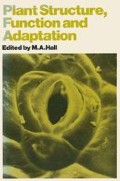Abstract
Water is the most abundant constituent of living things. The living tissues of plants usually contain more than 70 per cent by weight of water, and maintenance of a satisfactory water content is essential for the plants to remain alive. Even quite small variations in plant-tissue water-content can markedly influence processes of growth and metabolism. Living things on this planet first evolved in water, and for hundreds of millions of years all plants lived totally immersed in water. One of the major hindrances to colonisation of the land was the great difficulty in controlling the water content of plant tissues exposed to the desiccating influence of the air; but eventually plants capable of such control did evolve. The most successful land plants of today can sustain continued water loss from aerial parts by maintaining an efficient uptake of water from the soil. Their tissue water balance is thus a dynamic one, a continual balancing of loss and gain. This explains why an emphasis on dynamics, an interest in movement of water, typifies the modern approach to plant water relations.
Preview
Unable to display preview. Download preview PDF.
Further Reading
Textbooks
P. J. Kramer, Plant and Soil Water Relationships: A Modern Synthesis (McGraw-Hill, New York, 1969).
F. B. Salisbury and C. Ross, Plant Physiology (Wadsworth, Belmont, Cal., 1969) ch. 2–7.
R. O. Slatyer, Plant—Water Relationships (Academic Press, London, 1967).
J. Sutcliffe, Plants and Water (Arnold, London, 1968). (Of these, Slatyer’s is the most advanced.)
Symposia
G. E. Fogg (ed.), ‘The State and Movement of Water in Living Organisms’, Symp. Soc. exp. Biol., 19 (1965).
T. T. Kozlowski (ed.), Water Deficits and Plant Growth, (3 vols) (Academic Press, London, 1968, 1972).
J. L. Monteith and P. E. Weatherley (eds), ‘The Water Relations of Plants’, Phil. Trans. R. Soc. B., (1975).
A. J. Rutter and F. H. Whitehead (eds), ‘The Water Relations of Plants’, Symp. Br. ecol. Soc., 3 (1963).
Specialised Reviews
P. E. Weatherley, ‘Some Aspects of Water Relations’, Adv. bot. Res., 3 (1970) pp. 171–206.
T. C. Hsaio, ‘Plant Responses to Water Stress’, A. Rev. Pl. Physiol., 24 (1973) pp. 519–570.
E. I. Newman, ‘Root and Soil Water Relations’, in The Plant Root and its Environment, ed. E. W. Carson (University Press of Virginia, 1974) pp. 363– 440.
Further Information on Plant Anatomy
Katherine Esau, Plant Anatomy (Wiley, New York, 1965).
Katherine Esau, Anatomy of Seed Plants (Wiley, New York, 1960).
A. Fahn, Plant Anatomy (Pergamon, Oxford, 1967).
Editor information
Editors and Affiliations
Copyright information
© 1976 Macmillan Publishers Limited
About this chapter
Cite this chapter
Newman, E.I. (1976). Water Relations. In: Hall, M.A. (eds) Plant Structure, Function and Adaptation. Palgrave, London. https://doi.org/10.1007/978-1-349-06571-4_5
Download citation
DOI: https://doi.org/10.1007/978-1-349-06571-4_5
Publisher Name: Palgrave, London
Print ISBN: 978-0-333-34455-2
Online ISBN: 978-1-349-06571-4
eBook Packages: Biomedical and Life SciencesBiomedical and Life Sciences (R0)

